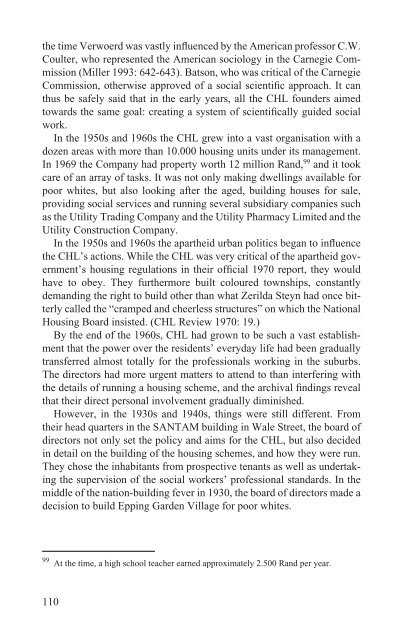The Making of a Good White - E-thesis - Helsinki.fi
The Making of a Good White - E-thesis - Helsinki.fi
The Making of a Good White - E-thesis - Helsinki.fi
You also want an ePaper? Increase the reach of your titles
YUMPU automatically turns print PDFs into web optimized ePapers that Google loves.
the time Verwoerd was vastly influenced by the American pr<strong>of</strong>essor C.W.<br />
Coulter, who represented the American sociology in the Carnegie Commission<br />
(Miller 1993: 642-643). Batson, who was critical <strong>of</strong> the Carnegie<br />
Commission, otherwise approved <strong>of</strong> a social scienti<strong>fi</strong>c approach. It can<br />
thus be safely said that in the early years, all the CHL founders aimed<br />
towards the same goal: creating a system <strong>of</strong> scienti<strong>fi</strong>cally guided social<br />
work.<br />
In the 1950s and 1960s the CHL grew into a vast organisation with a<br />
dozen areas with more than 10.000 housing units under its management.<br />
In 1969 the Company had property worth 12 million Rand, 99 and it took<br />
care <strong>of</strong> an array <strong>of</strong> tasks. It was not only making dwellings available for<br />
poor whites, but also looking after the aged, building houses for sale,<br />
providing social services and running several subsidiary companies such<br />
as the Utility Trading Company and the Utility Pharmacy Limited and the<br />
Utility Construction Company.<br />
In the 1950s and 1960s the apartheid urban politics began to influence<br />
the CHL’s actions. While the CHL was very critical <strong>of</strong> the apartheid government’s<br />
housing regulations in their <strong>of</strong><strong>fi</strong>cial 1970 report, they would<br />
have to obey. <strong>The</strong>y furthermore built coloured townships, constantly<br />
demanding the right to build other than what Zerilda Steyn had once bitterly<br />
called the “cramped and cheerless structures” on which the National<br />
Housing Board insisted. (CHL Review 1970: 19.)<br />
By the end <strong>of</strong> the 1960s, CHL had grown to be such a vast establishment<br />
that the power over the residents’ everyday life had been gradually<br />
transferred almost totally for the pr<strong>of</strong>essionals working in the suburbs.<br />
<strong>The</strong> directors had more urgent matters to attend to than interfering with<br />
the details <strong>of</strong> running a housing scheme, and the archival <strong>fi</strong>ndings reveal<br />
that their direct personal involvement gradually diminished.<br />
However, in the 1930s and 1940s, things were still different. From<br />
their head quarters in the SANTAM building in Wale Street, the board <strong>of</strong><br />
directors not only set the policy and aims for the CHL, but also decided<br />
in detail on the building <strong>of</strong> the housing schemes, and how they were run.<br />
<strong>The</strong>y chose the inhabitants from prospective tenants as well as undertaking<br />
the supervision <strong>of</strong> the social workers’ pr<strong>of</strong>essional standards. In the<br />
middle <strong>of</strong> the nation-building fever in 1930, the board <strong>of</strong> directors made a<br />
decision to build Epping Garden Village for poor whites.<br />
99 At the time, a high school teacher earned approximately 2.500 Rand per year.<br />
110
















